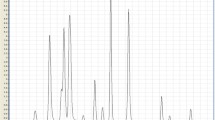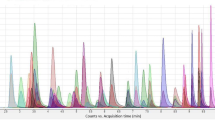Abstract
Interest on keratinized matrix analysis for clinical and forensic purposes has been recently grown due to the wide temporary detection window for psychotropic and toxic substances entrapped after repeated consumption. The aim of this study was the development and full validation of an UHPLC-MS/MS screening method to quantify 119 molecules among most abused classic drugs and new psychoactive substances in hair and in nails, to assess the polyconsumption. Twenty-five milligrams of hair or nail samples, added with the internal standard mixture, were cut and incubated with 500 μL M3® buffer reagent at controlled temperature. After cooling, 1 μL supernatant was injected in the chromatographic system equipped with an Oasis HLB column. After the 10 min chromatographic separation through a gradient mobile phase (aqueous ammonium formate, phase A; acetonitrile, phase B), the target compounds were detected in multiple reaction monitoring mode. The method was linear (r2 always better than 0.99) in a calibration range of LOQ 20000 pg compound for milligram hair and of LOQ 1000 pg compound per milligram nail. Process efficiency of analytes under investigation was always better than 65% and no significant ion suppression due to matrix effect was observed. Intra-assay and inter-assay precision and accuracy were always better than 15%. The applicability and trueness of the method were examined by analysing real samples of hair and nail from users of psychoactive drugs in recreational contexts. Both classic drugs and new psychoactive substances could be determined as result of single or repeated use and accumulation in keratin matrices.

Graphical abstract


Similar content being viewed by others
References
Cooper GAA, Kronstrand R, Kintz P. Society of Hair Testing guidelines for drug testing in hair. Forensic Sci Int. 2012;218:20–4.
Palmeri A, Pichini S, Pacifici R, Zuccaro P, Lopez A. Drugs in nails. Physiology, pharmacokinetics and forensic toxicology. Clin Pharmacokinet. 2000;38:95–110.
Solimini R, Minutillo A, Kyriakou C, Pichini S, Pacifici R, Busardò FP. Nails in forensic toxicology: an update. Curr Pharm Des. 2017;23:5468–79.
Busardò FP, Gottardi M, Pacifici R, Varì MR, Tini A, Volpe AR, et al. Nails analysis for drugs used in the context of Chemsex: a pilot study*. J Anal Toxicol. 2019:1–6.
Marchei E, Palmi I, Pichini S, Pacifici R, Anton Airaldi IR, Costa Orvay JA, et al. Segmental hair testing to disclose chronic exposure to psychoactive drugs. Adicciones. 2016;28:158–62.
UNODC. World drug report 2019. Available from: https://reliefweb.int/report/world/unodc-world-drug-report-2019 Accessed 26 November 2019.
European Monitoring Centre for Drugs and Drug Addiction. European Drug Report 2019: Trends and developments. Luxemburg; 2019 Available from: http://wwwemcddaeuropaeu/edr2019_en Accessed 26 November 2019.
UNODC Early Warning Advisory on new psychoactive substances. What are NPS?. UNODC. Available at https://www.unodc.org/LSS/Page/NPS Accessed 26 November 2019.
Pantano F, Graziano S, Pacifici R, Busardò FP, Pichini S. New psychoactive substances: a matter of time. Curr Neuropharmacol. 2019;17:81822.
Zaami S, Giorgetti R, Pichini S, Pantano F, Marinelli E, Busardò FP. Synthetic cathinones related fatalities: an update. Eur Rev Med Pharmacol Sci. 2018;22:268–74.
Solimini R, Pichini S, Pacifici R, Busardò FP, Giorgetti R. Pharmacotoxicology of non-fentanyl derived new synthetic opioids. Front Pharmacol. 2018;20(9):654.
Pichini S, Pacifici R, Marinelli E, Busardò FP. European drug users at risk from illicit fentanyls mix. Front Pharmacol. 2017;8:785.
Pichini S, Solimini R, Berretta P, Pacifici R, Busardò FP. Acute intoxications and fatalities from illicit fentanyl and analogues: an update. Ther Drug Monit. 2018;40:38–51.
Barceló B, Pichini S, López-Corominas V, Gomila I, Yates C, Busardò FP, et al. Acute intoxication caused by synthetic cannabinoids 5F-ADB and MMB-2201: a case series. Forensic Sci Int. 2017;273:e10–4.
Zaami S, Busardò FP, Pichini S, Pacifici R, Marinelli E. The value of toxicological and forensic analyses in the global challenge to health risks caused by new psychoactive substances. Eur Rev Med Pharmacol Sci. 2019;23:6008–10.
Nisbet LA, Wylie FM, Logan BK, Scott KS. Gas chromatography-mass spectrometry method for the quantitative identification of 23 new psychoactive substances in blood and urine. J Anal Toxicol. 2019;43:346–52.
Wagmann L, Maurer HH. Bioanalytical methods for new psychoactive substances. Handb Exp Pharmacol. 2018;252:413–39.
Mercieca G, Odoardi S, Cassar M, Strano RS. Rapid and simple procedure for the determination of cathinones, amphetamine-like stimulants and other new psychoactive substances in blood and urine by GC-MS. J Pharm Biomed Anal. 2018;149:494–501.
Lehmann S, Kieliba T, Beike J, Thevis M, Mercer-Chalmers-Bender K. Determination of 74 new psychoactive substances in serum using automated in-line solid-phase extraction-liquid chromatography-tandem mass spectrometry. J Chromatogr B Anal Technol Biomed Life Sci. 2017;1064:124–38.
Vaiano F, Busardò FP, Palumbo D, Kyriakou C, Fioravanti A, Catalani V, et al. A novel screening method for 64 new psychoactive substances and 5 amphetamines in blood by LC-MS/MS and application to real cases. J Pharm Biomed Anal. 2016;129:441–9.
Odoardi S, Fisichella M, Romolo FS, Strano-Rossi S. High-throughput screening for new psychoactive substances (NPS) in whole blood by DLLME extraction and UHPLC-MS/MS analysis. J Chromatogr B Anal Technol Biomed Life Sci. 2015;1000:57–68.
Kinyua J, Negreira N, Miserez B, Causanilles A, Emke E, Gremeaux L, et al. Qualitative screening of new psychoactivesubstances in pooled urine samples from Belgium and United Kingdom. Sci Total Environ. 2016;573:1527–35.
Peters FT. Recent developments in urinalysis of metabolites of new psychoactive substances using LC-MS. Bioanalysis. 2014;6:2083–107.
Boumba VA, Di Rago M, Peka M, Drummer OH, Gerastamoulos D. The analysis of 132 novel psychoactive substances in human hair using a single step extraction by tandem LC/MS. For Sci Int. 2017;279:192–202.
Freni F, Bianco S, Vignali C, Groppi A, Moretti M, Osculati AMM, et al. A multi-analyte LC–MS/MS method for screening and quantification of 16 synthetic cathinones in hair: application to postmortem cases. For Sci Int. 2019;298:115–20.
Strano-Rossi S, Odoardi S, Fisichella M, Anzillotti L, Gottardo R, Tagliaro F. Screening for new psychoactive substances in hair by ultrahigh performance liquid chromatography–electrospray ionization tandem mass spectrometry. J Chromatogr A. 2014;1372:145–56.
Lendoiro E, Jiménex-Morigrosa C, Cruz A, Pàramo M, Lòpez-Rivadulla M, de Castro A. An LC-MS/MS methodological approach to the analysis of hair for amphetamine-type-stimulant (ATS) drugs, including selected synthetic cathinones and piperazines. Drug Test Anal. 2016;9:96–105.
Salomone A, Palamar JJ, Gerace E, Di Corcia D, Vincenti M. Hair testing for drugs of abuse and new psychoactive substances in a high-risk population. J Anal Toxicol. 2017;41:376–81.
Larabi IA, Fabresse N, Etting I, Nadour L, Pfau G, Raphalen JH, et al. Prevalence of new psychoactive substances (NPS) and conventional drugs of abuse (DOA) in high risk populations from Paris (France) and its suburbs: a cross sectional study by hair testing (2012–2017). Drug Alcohol Depend. 2019;204:107508.
Salomone A, Gazzilli G, Di Corcia D, Gerace E, Vincenti M. Determination of cathinones and other stimulant, psychedelic, and dissociative designer drugs in real hair samples. Anal Bioanal Chem. 2016;408:2035–42.
Imbert L, Dulaurent S, Mercerolle M, Morichon J, Lachatre G, Gaulier JM. Development and validation of a single LC–MS/MS assay following SPE for simultaneous hair analysis of amphetamines, opiates, cocaine and metabolites. For Sci Int. 2014;234:132–8.
Rotolo MC, Klein J, Pacifici R, Busardo FP, Pichini S, Marchei E. Analytical strategies to disclose repeated consumption of new psychoactive substances by hair analysis. Curr Pharm Biotechnol. 2017;18:834–9.
Kyriakou C, Pellegrini M, García-Algar O, Marinelli E, Zaami S. Recent trends in analytical methods to determine new psychoactive substances in hair. Curr Neuropharmacol. 2017;15:663–81.
Peters FT, Wissenbach DK, Busardo FP, Marchei E, Pichini S. Method development in forensic toxicology. Curr Pharm Des. 2017;23:5455–67.
Wille SMR, Coucke W, de Baere T, Peters FT. Update of standard practices for new method validation in forensic toxicology. Curr Pharm Des. 2017;23:5442–54.
Matuszewski B, Constanzer M, Chavez-Eng C. Strategies for the assessment of matrix effect in quantitative bioanalytical methods based on HPLC–MS/MS. Anal Chem. 2003;75:3019–30.
Vincenti F, Montesano C, Cellucci L, Gregori A, Fanti F, Compagnone D, et al. Combination of pressurized liquid extraction with dispersive liquid liquid micro extraction for the determination of sixty drugs of abuse in hair. J Chromatogr A Elsevier BV. 2019;1605:360348.
United Nations Office on Drugs and Crime (UNODC). World Drug Report 2018 Analysis of drug markets: World Drug Rep. 2018. http://www.unodc.org/wdr2018/prelaunch/WDR18_Booklet_3_DRUG_MARKETS.pdf.
Salomone A, Luciano C, Di Corcia D, Gerace E, Vincenti M. Hair analysis as a tool to evaluate the prevalence of synthetic cannabinoids in different populations of drug consumers. Drug Test Anal. 2014;6(1–2):126–34.
Salomone A, Bigiarini R, Palamar JJ, et al. Toward the interpretation of positive testing for fentanyl and its analogs in real hair samples: preliminary considerations. J Anal Toxicol. 2019. https://doi.org/10.1093/jat/bkz102.
Marchei E, Pacifici R, Mannocchi G, Marinelli E, Busardò FP, Pichini S. New synthetic opioids in biological and non-biological matrices: a review of current analytical methods. Trends Anal Chem. 2018;102:1–15.
Busardò FP, Gottardi M, Pacifici R, et al. Nails analysis for drugs used in the context of Chemsex: a pilot study. J Anal Toxicol. 2019. https://doi.org/10.1093/jat/bkz009.
Acknowledgements
The authors would like to thank Simonetta di Carlo, Laura Martucci for the technical assistance and Soraya Martín (RN) for her valuable assistance throughout the clinical study. Oronzo Persano is acknowledged for manuscript editing and uploading.
Funding
The investigation was partially carried out with funding from Presidency of the Ministers Council, Department of Antidrug Policy and from Department of Excellence SBSP, University “Politecnica delle Marche” of Ancona.
Author information
Authors and Affiliations
Corresponding author
Ethics declarations
Conflict of interest
The authors declare that they have no conflicts of interest.
Ethical approval
All procedures performed in the present study were in accordance with the ethical standards of the Università Politecnica delle Marche local committee and with the 1964 Helsinki declaration and its later amendments or comparable ethical standards.
Additional information
Published in the topical collection Euroanalysis XX with guest editor Sibel A. Ozkan.
Publisher’s note
Springer Nature remains neutral with regard to jurisdictional claims in published maps and institutional affiliations.
Rights and permissions
About this article
Cite this article
Mannocchi, G., Di Trana, A., Tini, A. et al. Development and validation of fast UHPLC-MS/MS screening method for 87 NPS and 32 other drugs of abuse in hair and nails: application to real cases. Anal Bioanal Chem 412, 5125–5145 (2020). https://doi.org/10.1007/s00216-020-02462-6
Received:
Revised:
Accepted:
Published:
Issue Date:
DOI: https://doi.org/10.1007/s00216-020-02462-6




